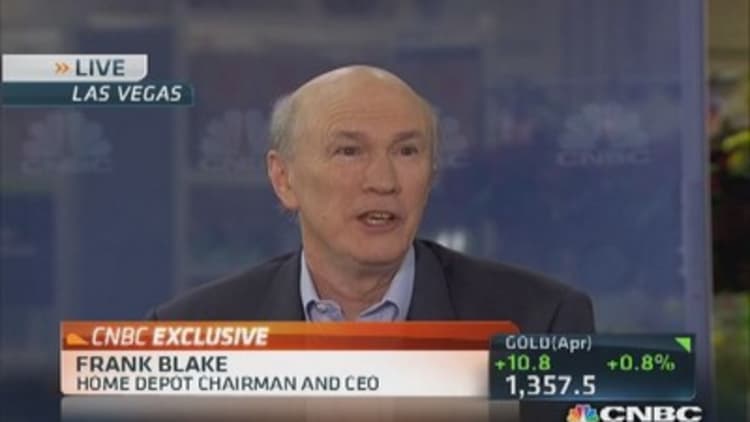Dreaming of an outdoor barbecue, with the sun beaming down on your skin as you lounge on your brand-new patio furniture?
Spring is like Christmas for home improvement retailers, and right now these stores likely feel like 5-year-olds who can hardly wait for Santa to come. But with seven inches of snow on the ground in Philadelphia and Washington, and below freezing temperatures in New York City, it's hard for many consumers to shake the winter blues and start making purchases for spring.
Traffic to home improvement stores has lagged in weather-affected regions, yet experts remain confident that pent-up demand and a normalization in weather patterns will carry the segment to positive sales for March.
"We still have plenty of runway left," said Evan Gold, senior vice president of client services at Planalytics, a consulting firm that analyzes the effect of weather on consumer demand. "We just need a normal snap for things to pop."
(Read more: Too cold for you to play golf? You're not alone)
Home improvement sales typically begin picking up volume in late February or early March, and the push tends to culminate in May, said UBS analyst Michael Lasser. Both Home Depot and Lowe's last year posted about 30 percent of their sales from May to August. That means the cold snap shouldn't weigh too heavily on retailers' top line.
At the UBS Global Consumer Conference on Thursday, Lowe's indicated that while spring purchases appear to be delayed among shoppers, sales have picked up on days when the weather was nice. That likely indicates pent-up demand, Gold said.
He added that the weather in areas such as Florida—where spring sales tend to pick up sooner—has been significantly warmer than last year, when the state experienced its fifth coldest March.
(Read more: Cold weather could mean hot sales for these brands)
As such, Planalytics predicts sales will pick up toward the end of the month, creating a 5 percent sales boost for the lawn and garden category, led by the Southeast region.
"A lot of the sales in March, especially the early part, come from the Southeast and the Southwest... and they've already popped," Gold said.
According to industry research firm IBISWorld, the home improvement industry is expected to grow its revenue at an annualized rate of 2.2 percent for the five years leading to 2014, reaching $143.6 billion. Home Depot and Lowe's—which together make up about 90 percent of the home improvement market—both sounded a bullish note on 2014, after bucking the industry trend and posting positive same-store sales figures for the fourth quarter.
Both retailers cited an improving housing market—characterized by an increase in home ownership and home values—as sales drivers.

Still, the sector is growing tired of the waiting game.
Home Depot CEO Frank Blake told CNBC last week that spring has been "challenging" because it's been so delayed. He said the retailer's best-selling product has been snow throwers, which is not in the store's best interest at this juncture.
"We would prefer people be buying, at this point, more outdoor garden," Blake said.
Another headwind comes from an increase in heating bills this winter. According to the U.S. Energy Information Administration predictions, the excessive winter cold drove the average cost of heat for a propane-powered home 54 percent higher this winter, compared to the prior year. Increases were also seen in homes warmed by heating oil, natural gas and electricity.
(Read more: St. Paddy's Day snow! DC hit by two inches an hour)
This will likely have an impact on consumers' discretionary spending for spring. Although Lasser said he's confident home improvement is a place consumers will continue to spend their money, he acknowledged that winter bills are a factor.
Gold agreed.
"If there's anything discretionary that they can do they will, but certainly people are going to be battling sticker shock for their home heating bills," he said. "[But] I think the month overall should be more favorable than last year."
—By CNBC's Krystina Gustafson. Follow her on Twitter @KrystinaGustafs.


